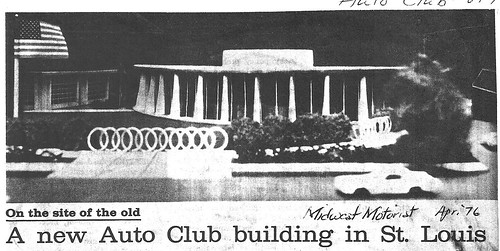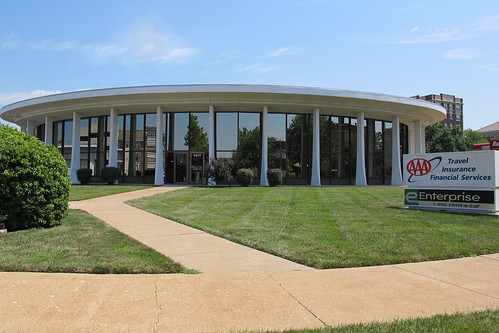by Michael R. Allen
After the Auto Club of Missouri’s adopted headquarters in the former Columbian Club at 3917 Lindell Boulevard burned in 1975, the organization sought to construct a new headquarters. The leadership decided to relocate the headquarters to a site on Mason Road at Highway 40 in west St. Louis County. However, the Auto Club — an affiliate of the AAA — decided to retain its long-time Central West End site for a new member services office and automobile diagnostic center.

The April 1976 issue of Midwest Motorist reported that the club had hired Sarmiento Architects, led by designer W.A. Sarmiento, to design a new 7,500 square-foot office building as well as an 18,000 square foot diagnostic center in an existing garage to the west (built in 1967). Construction was estimated to cost $500,000. According to H. Sam Priest, president of the Auto Club of Missouri, the facility was to be “the largest and most complete of its kind in the territory.” The club served Missouri, southern Illinois and Johnson and Wyandotte counties in Kansas.
The article in Midwest Motorist included bullish quotes on the new facility from Mayor John Poelker, St. Louis University Chancellor the Rev. Paul Reinert and Washington University Chancellor William C. Danforth. All three welcomed a new facility in what was seen as a key area linking the university campuses and downtown St. Louis. Indeed, Lindell Boulevard was a major thoroughfare that was actively rebuilt between 1939 and 1977. At least 34 new buildings were built there between Grand and Kingshighway in that period, in addition to several major re-cladding projects. Most of the new and redesigned buildings were in Modern Movement styles. (Take a self-guided tour of mid-century modern architecture on Lindell here.)

W.A. (Wenceslao or “Wence”) Sarmiento had already left his mark on Lindell Boulevard. The Peruvian-born designer had served as chief architect for the Bank Building and Equipment Corporation from 1952 through 1964. In that capacity, Sarmiento designed the Chancery of the Archdiocese of St. Louis at 4445 Lindell Boulevard (1963). That distinctive building made use of steel, plate glass and thin-shell concrete to articulate a circular form. That form allowed for placement of a two-story open rotunda around which offices were arranged. The exterior challenged the tenets of the International Style by encasing the steel columns in shaped cladding, applying geometric metal grilles over the glazing and placing the space-age structure on a podium of ashlar-bonded rusticated limestone. Yet the building retains a classical austerity.

For the Auto Club of Missouri’s new building, Sarmiento again explored the application of classical formal principles to a rounded building form that symbolically adopted the shape of the national AAA logo. The one-story building was elliptical in shape, and placed at an angle on the site so that the main entrance faced Lindell Boulevard on a southwest diagonal axis. The northwest face of the building was largely unarticulated, save a drive-through window, but the main face was drawn out as a temple front with a colonnade of columns supporting an entablature and projecting cornice. Of course, the columns were of no pure order, but geometrically derived tapered concrete members. Likewise, the entablature and cornice elements were squared off, abstract concrete elements. Behind the colonnade, the wall was glazed with mirrored glass that rose the full height of the wall plane. All of these elements concealed the raw expression of building form, giving it stylistic characteristics common to the New Formalism of the 1970s.
Sarmiento’s detailing did not stop at the building entrance. Inside of the Auto Club’s building, the form of the building revealed its logic. The elliptical form allowed for a large main lobby with seating ringed by a curved bank of stations for various Auto Club agents. The design evoked Sarmiento’s acumen at bank design, but also was purely functional for the building’s purpose. Inside, Sarmiento chose to have each column rise into a lighted ceiling vault. Descending from each vault were thin mental bands that joined to clad each column. Again, the architect avoided the purely functional expression for ornamental flourish. (One ornamental landscape element that was never built was a series of metal fences of interlocked circles on the lawn.)

The Auto Club of Missouri’s building is now known as the AAA Building and retains its original function. The Department of Motor Vehicles’ station inside of the lobby draws many people into this iconic modernist building. Yet the AAA of Missouri, successor to the Auto Club, wants to sell the building to a CVS affiliate company that would demolish it for a new chain drug store. Not only would demolition destroy a significant work of architecture, it would diminish the long historic association of the AAA with the site. How either of those things honors the history of the Auto Club of Missouri and the AAA is beyond the grasp of this writer.
The Preservation Board will consider demolition of the AAA Building as a preliminary review on Monday, June 25 at 4:00 p.m. (Meeting agenda here.) The meeting takes place at 1520 Market Street, in room 2000 on the second floor. Public testimony is welcome, either at the meeting or by e-mail to Board Secretary Adona Buford at BufordA@stlouiscity.com.

2 replies on “The Auto Club of Missouri’s Proud New Building”
It doesn’t honor the AAA or Auto Club of Missouri. Â That’s not their intent, though, is it? Â They are probably thinking that bringing in a big check honors the AAA better than anything, and from what I’ve heard, CVS is honoring property owners with very big checks. Â
 Just what St. Louis needs, another large chain pharmacy. I mean there are so few of them now they are hard to find. I think a better location would be at Grand and Lindell, they could tear down St Xavier Church. Hell, better yet, go downtown and tear down city hall, it is pretty well a useless building anyway.